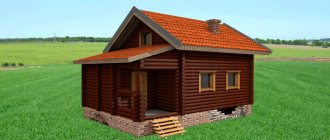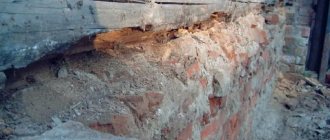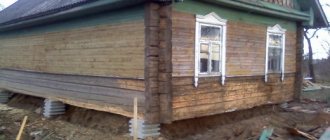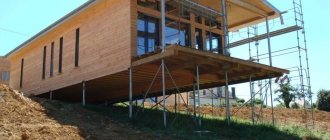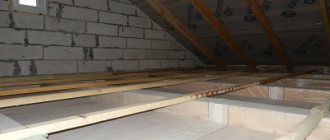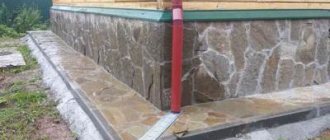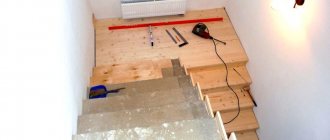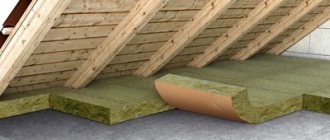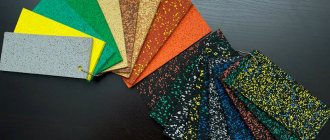Even the best of them, installed in a residential building over the course of a year, are capable of passing through hundreds of liters of liquid absorbed from the vapor-air environment formed during human life.
Additional sources of moisture in the house can be disturbances in the operation of plumbing, sewerage or roofing systems, thereby increasing the humidity in residential areas.
High levels of humidity contribute to the creation of dangerous microclimates, mold on walls and furniture, and lead to more serious structural problems in the home. Such a humid environment can damage walls, ceilings, wooden floors and pieces of furniture that are located in it.
Installing hydro- and vapor barriers on floor slabs will help protect house construction from such shortcomings. And existing innovative solutions for modernizing building structures in residential buildings allow such activities to be carried out efficiently even without dismantling the slab.
When is a vapor barrier between the first and second floor needed?
Vapor barrier is necessary when there are temperature changes, when the first floor is heated, but the second is not (that is, cold). Warm air penetrates the insulation, passes the dew point, and condenses. As a result, the insulation gets wet, and the floors swell and collapse. Vapor barrier is also necessary in rooms with high humidity: in the bathroom, kitchen, if the house has a swimming pool.
If the first and second floors are heated, it is necessary to isolate only rooms with high humidity from steam so that the steam does not destroy the insulation. In other rooms (corridors, rooms) good ventilation will be sufficient.
Why is vapor barrier needed?
A vapor barrier is installed directly in front of the insulation if there is a risk of steam entering (for example, in the bathroom or kitchen) or condensation forming in the insulation. If warm, humid air enters an area where the temperature is at least 10 degrees lower, it condenses and moisture penetrates the walls and insulation. Thermal insulation loses its properties, and fungus and mold form on the walls.
What materials are suitable for vapor barrier
For vapor barrier, special vapor barrier films are used. Such films protect the inner surface of the walls and insulation from the negative effects of condensation and steam. The films are used in floors, walls and roofs; they are compatible with all types of thermal insulation made from mineral wool, ecowool, polystyrene foam and its derivatives.
Films are suitable for vapor barrier
Ondutis B (R70)
or
B (R70) Smart
. “Smart” film is distinguished by the presence of adhesive tape at the joints, which greatly simplifies installation and reliably seals the joints.
A very important point when installing a vapor barrier is ensuring tightness during installation. If the film is not glued tightly or cuts appear, all the work will be done in vain.
conclusions
We talked about the basic principles of installing vapor barrier films and membranes in insulated wooden floors. The main approach is to protect the insulation from steam and, if water vapor gets into the ceiling, to escape. Those. do not lock the thermal insulation into two layers of vapor barrier , and this mistake is often made. And do not wrap wooden beams with vapor barrier, unless it is a film specifically designed for this purpose. Another nuance - ensure the tightness of the vapor barrier . Overlaps, joints, and junctions with walls, skylights, stove and ventilation pipes must be sealed with materials recommended by film and membrane manufacturers.
We recommend the topic Waterproofing in a cold attic, which tells you whether it is necessary to install waterproofing under the roofing.
- What does improper vapor barrier lead to: real experience and repair methods
- The correct “pies” of a frame wall, which are recommended by FORUMHOUSE users.
- The most complete instructions on the RuNet for installing a roof window with the stages of installing a vapor barrier, a moisture-proof film and a gutter for condensate drainage.
Where to put the insulation
This question is very important, because if you put the material in the wrong place, it will not work or it will work, but incorrectly. It is important to remember one rule: vapor barrier is always installed on the warm air side, and waterproofing on the cold air side . Typically, these materials work together, providing reliable protection for the floors in the house from all types of moisture.
Vapor barrier film is laid on top of the floor insulation
Thus, it turns out that the vapor barrier of the wooden floor of the first floor should be carried out after installing the thermal insulation material, and protection from moisture in the air for interfloor ceilings or the attic should be laid from below.
The vapor barrier film of interfloor and attic floors is laid underneath the insulation
If you lay the material correctly, you don’t have to worry about the safety of the structures.
Pie layer diagram
According to current standards, technical solutions for the installation of floor slabs must ensure reliable waterproofing of thermal insulation materials and limit the penetration of water vapor into them as much as possible. And the relative arrangement of the layers should eliminate the prerequisites for the accumulation of moisture in the body of the structure and create conditions for its weathering.
The layout of layers in a multilayer wooden floor:
- Floor board.
- Waterproofing layer.
- Counter-lattice.
- Thermal protection.
- Counter beam.
- Thermal protection.
- Floor beam.
- Rough filing.
- Vapor barrier.
Vapor barrier functions
When attached to a ceiling or floor structure in a house, a vapor barrier serves not only the purpose stated above. The laying of the material allows us to say the following:
- the ceiling structure, in addition to protection from moisture, receives protection from most types of organic damage (mold, rot, fungus), which require warm and humid conditions to reproduce;
- laying film in the ceiling of a basement, attic or in interfloor structures can significantly increase the service life of wood and reduce the frequency of repairs (significant savings during operation);
- modern materials can create additional protection for the ceiling in the event of a fire and increase its fire resistance, which is important so that people in the house have time to evacuate;
- laying a material that has a good service life is a single event; most often, replacement of the vapor barrier is not required, the layer does not fail.
Ceiling vapor barrier options
Reliable water vapor barrier can eliminate many problems with floors and roofing. The choice of material in a private house depends on the financial capabilities and wishes of the future owner. Previously, polyethylene film was used almost everywhere as a water vapor barrier, but it is not able to fully perform both functions when laid in the ceiling.
Polyethylene film cannot simultaneously act as a water vapor barrier
It is better to give preference to more modern materials that guarantee high quality protection for the ceiling and floors in the house. There are several forms of materials release. The following types of mastics for coating structures are available on the market:
- cold asphalt;
- hot based on bitumen;
- polyvinyl chloride;
- lingo-sulfonate based on bitumen;
- rubber;
- Kukersol based on bitumen.
Treating the ceiling in a house with such materials is complicated by the fact that the water vapor barrier of the floors is applied to a horizontal surface located above a person’s height. The worker will have to constantly keep his head up. Such working conditions significantly reduce quality. To ensure reliable protection, it is recommended to consider an option such as vapor barrier membranes (not to be confused with vapor diffusion membranes, which act as waterproofing and release water vapor to the outside) .
Modern membranes for protecting the ceiling and floors in the house include the following types of materials:
- Membranes with variable vapor transmission ability.
They can work to prevent moist air from passing in both directions. This type of water vapor barrier for floors will allow you not to worry when the humidity conditions in the room change; the film will be able to adapt to it independently. Adaptive film has variable vapor transmission ability - Membranes with limited vapor permeability.
Their ability to remove moisture is strictly regulated and depends on the choice of material. They are configured to remove excess moisture from the volume of the room. Film with limited vapor permeability is suitable for houses with non-permanent residence - Membranes with aluminum foil.
The use of such materials will ensure a high degree of protection of the load-bearing structures of the house from steam. In addition to removing moisture, such a water vapor barrier allows you to retain heat inside the room. It is reflected from the foil surface and does not leave the volume of the room. This property is especially important during the repair and construction of baths, bathrooms and other rooms in which it is necessary to maintain elevated air temperatures. Heat-reflective vapor barrier keeps the room warm
Features of vapor barrier for wooden ceilings
Installation of any material is quite simple. Due to the diversity, it is difficult to provide one universal method. Most often, the manufacturer indicates precise recommendations for the use of its material and requirements for the work.
Manufacturers most often produce both hydro and vapor protection simultaneously. It is best to choose two films (vapor barrier and waterproofing) from one company to isolate insulation and wood from moisture . This will allow us to talk about reliable protection and compliance with technology.
Ceiling vapor barrier diagram
Regarding fastening the material indoors (and it is always fastened from the inside, protecting the elements from the warm air of the room, regardless of what kind of structure is being finished), the following recommendations can be given to home craftsmen:
- Do not forget about the multi-layer structure of the ceiling. If you list the layers fixed from the inside from bottom to top, you will get the following sequence: sheathing, vapor barrier, floor frame, insulation, waterproofing, floor structure. This procedure is suitable for interfloor and attic floors. When laying the material from the attic side, the location of the vapor barrier, insulation and waterproofing relative to each other does not change.
- Before laying the material, the surface must be primed with compounds that include antiseptic components.
- Subsequent layers can be attached only after the primer has completely dried.
- The vapor barrier must extend onto the wall by at least 20 cm. It is also necessary to ensure that the material sheets overlap (at least 10 cm) and that the joints and attachment points to the frame are taped.
- A sheathing is installed on top of the vapor barrier, onto which the ceiling sheathing will be attached. The lathing can be either wooden or metal profile.
In order to reduce heat loss through building structures, they are equipped with a layer of thermal insulation. Almost all types of insulation need to be protected from the penetration of atmospheric water from the outside and household fumes from the inside.
The construction of a vapor barrier cannot be neglected, because this component of the insulation system plays no less a role than waterproofing. It is especially important to know how a vapor barrier is constructed for a ceiling in a wooden floor, since materials that are extremely sensitive to excess water are used in its construction.
The role of vapor barrier in construction
Building structures from the inside are constantly affected by steam flows released during mandatory household work, breathing of household members, hygiene procedures, etc. The penetration of water suspended in the air into the systems that enclose and insulate a house negatively affects their technical and operational properties.
On surfaces moistened with steam, colonies of fungi settle at a brisk pace, rendering almost all types of building materials unusable with amazing speed. Wooden elements rot and collapse. Wet insulation loses about half of its insulating qualities, because... The water contained in it significantly increases thermal conductivity.
Warm air, saturated with water suspended in it, always rushes to where the pressure and moisture content are lower. In our northern latitudes, for most of the year, the temperature and humidity parameters inside buildings are significantly higher than outside them. This feature explains the direction of movement of steam-containing air masses moving from indoors to the external environment.
The predominant volume of evaporation, according to its own physical nature, is directed upward to “exit” into the atmosphere through the enclosing systems. The most active air flows that include steam “attack” the ceiling, the upper segment of the walls and the roof structure. It is they who need to be strongly protected from the penetration of water in the air.
The process of air masses flowing into areas with lower pressure and water saturation is called diffusion. There is nothing particularly scary about it if no mistakes were made during the construction of building structures. Humid air simply will not penetrate the thickness of the insulating pie or move outside without causing damage to the structure.
However, if during the construction of a house with insulation systems violations of technological rules were made, water will begin to linger in the enclosing structures. At best, the result will be increased heat loss, a feeling of eternal cold and dampness. In the worst case, destruction or damage to structures is coming, dictating mandatory major repairs.
Steam protection of attic floors
The function of the vapor barrier film in a thermal insulation cake is to prevent water suspended in the air from penetrating into building structures. This means that it is the vapor barrier that must stop the evaporation in order to either not let through at all or reduce to minimum values what managed to pass through it.
We have already found out that in our regions, steam, along with the air flow, most often moves from buildings to the outside. Only in the summer heat is reverse current possible. The vapor barrier layer should be the first in the path of moist air. Consequently, it is laid on the side of the used premises before thermal insulation.
The installation of a vapor barrier along the ceiling is carried out if the attic is not intended to be heated. In this case, there is no point in insulating the attic space at all, because... it will not be used at all or will be used as a cold warehouse.
True, it is still necessary to protect the materials of the sheathing of the slopes and rafter frame. Waterproofing is installed against external influences, and a ventilation system is installed against the formation of condensation occurring due to the difference in temperatures inside and outside the structure.
According to the requirements of building regulations, in winter, the temperature within a cold attic should not exceed that outside by more than 5 - 6º C. The rules outlined in SP 17.13330.2011 state that in order to equalize the temperature and humidity parameters inside and outside the attic, it is necessary to arrange a natural type of ventilation.
This means that it is necessary to provide the roof structure with vents, dormer windows, aerators, etc. The total area of ventilation openings, regardless of their type and purpose, should be on average 1/300 of the floor area or horizontal projection of the roof. The described measure is quite sufficient to maintain the temperature and humidity balance specified by building regulations.
Specifics of the vapor barrier device
Materials with the lowest vapor permeability are used as vapor barrier protection for the attic floor. This characteristic indicates the ability to conduct evaporation in a certain volume per unit area, indicated in mg/m² per day. All building materials have it to a greater or lesser extent.
Despite the ability of wood to freely allow evaporation to pass through, excess exposure to moisture is undesirable. Natural organic matter is unstable in linear dimensions; when moistened, it expands. Naturally, this property is usually taken into account by designers, but excessive movements of the elements of wooden structures do not benefit them, and moreover, they often lead to rotting.
For the normal operation of the ceiling located under a cold attic, it is necessary to correctly arrange the components according to their ability to pass humidified air. The component with the minimum ability to conduct steam should be placed first, then with vapor permeability greater than the previous one.
Therefore, for a steam protection device, materials with the ability to transmit steam close to zero or equal to fractions of one are mainly selected. Note that it can be several dozen, but must be less than that of thermal insulation. Even taking into account the fact that wood has a fairly high ability to conduct steam, the material for the device to protect against it should not allow more than a few tens of mg/m² of vapor to pass through per day.
The diagram of an insulated wooden floor, when viewed from the side of the premises being equipped, should look like this:
- Vapor barrier. A layer made of glassine, diffusion membrane, polypropylene or polyethylene film. During construction it is laid on top of the ceiling. When performing repairs, it is installed on the ceiling from the side of the rooms, glued or secured with slats.
- Thermal insulation. A layer made of backfill, roll or slab types of insulation. Most often it fills the space between floor beams, less often it is laid on top of the floor on a rough flooring or screed. If the attic is not intended to be used, then the thermal insulation is installed without waterproofing and wind protection.
- Waterproofing. A layer made of a diffusion membrane or perforated polyethylene. Installed only in the case of attic use, placed under the flooring or flooring.
If you do not plan to use the attic, then there is no need to install waterproofing on top of the insulating layer. It is transferred to the slopes, where it does the job of protecting the entire roofing system from atmospheric water. The insulation layer over the ceiling also does not require wind protection, because The enclosing structure itself protects from heat blowing out of its thickness.
To service the roofing system, ladders are installed within the unused attic. They are laid directly on the joists if slab or roll material is used. The drains are installed on legs if the insulation was formed by filling with expanded clay. Insulation materials laid loosely in the attic must be periodically “loosened” so that caking does not reduce the insulating properties.
Technological subtleties of laying a vapor barrier
The vapor barrier layer under the insulation is laid in the form of a pallet with peculiar sides extending onto the walls. Those. so that this barrier is not only between the ceiling and the thermal insulation, but also between the insulation and the parts of the walls in contact with it. Each beam or wall of the panels must be covered with protective material.
Laying of vapor barrier material on the ceiling is carried out:
- With a bend around each beam. The material “without interference” is laid in longitudinal strips perpendicular to the beams with a recess into the space between the beams. The opening of the vapor barrier is carried out taking this circumstance into account. If the length of one strip is not enough, the panels are glued together.
- With wrapping from the inside of each compartment of the box-panel floor. The material is cut into pieces corresponding to the size of the shield and the height of its walls.
- With laying on top of the rough flooring or with fastening from the inside to the ceiling, if insulation is carried out in order to increase the insulating properties of the structure during the period of repair.
Regardless of the floor plan, the vapor barrier for the ceiling under the attic in a wooden house should form a continuous carpet that does not allow water to pass through or conducts it in a minimal amount. To do this, panels of rolled material are laid with the overlap specified by the manufacturer, the size of which is indicated in the instructions, and glued to each other with single- or double-sided tape.
The vapor barrier material should be rolled out over the ceiling as it was wound by the manufacturer. There is no need to turn over or rewind anything. In order not to confuse the sides of the installation, the manufacturer designates the side in contact with the ceiling.
How to choose the right material
It is important not only to install the vapor barrier correctly, but also to choose the most suitable material for its installation. Tandem vapor barrier - the insulation must work perfectly, preventing the possibility of the thermal insulation cake getting wet.
The most ancient version of the steam protection device is fatty clay, which was used to treat the ceiling from below or above. Paired with clay, a dry soil-vegetative layer was used to prevent the penetration of hot air in hot weather and cold air in cold weather. Instead of soil, fine peat, shavings, sawdust, dry leaves and similar materials can be used.
Instead of outdated insulating varieties, materials specially designed to protect against steam and heat loss are now used. Their installation is much easier and significantly faster. However, in terms of insulating properties they are inferior to old proven methods.
For the installation of vapor barrier protection for attic floors, the following are now used:
- Glassine . A budget option with a vapor permeability of about 70 mg/m² per day. It is used mainly in domestic buildings that do not require an increase in humidity levels above standard values.
- Films made of polypropylene and polyethylene . Vapor permeability is measured in units, approximately 3 – 5 mg/m² per day. Most of these are reinforced materials that are resistant to temperature changes, mechanical stress and UV radiation. Suitable for arranging wooden floors under backfill insulation.
- Vapor barrier membranes with foil shell . Vapor permeability averages 0.04 – 2.55 mg/m². They are used for arranging rooms with high humidity and unstable temperature conditions: saunas, steam rooms, Russian baths, swimming pools, combined bathrooms.
- Anti-condensation diffusion membranes . Their ability to transmit steam varies over a wide range from 3 to 15 or several tens of mg/m². These are the latest varieties of universal use. In a used attic floor, thermal insulation can be installed on the bottom and top sides.
Anti-condensation varieties are available in the form of double-sided polymer membranes. On one side, which should be facing the steam, they are rough, which prevents the formation of dew. The opposite side is smooth, it prevents the penetration of moisture from the outside.
Video about the rules for installing vapor barriers
An example of laying vapor barrier roll material on a ceiling:
Video about the specifics of laying vapor barrier film:
How to distinguish a vapor barrier material from a waterproofing option:
A vapor barrier constructed in accordance with technological requirements will eliminate premature wear and tear of building structures, eliminate costly heat leaks, and eliminate the possibility of dampness in a country house.
Specialized vapor barrier membranes were originally developed for a multi-layer roof insulation system. The material demonstrated excellent performance characteristics, so it was actively used for flooring.
Steam protection of attic floors
The function of the vapor barrier film in a thermal insulation cake is to prevent water suspended in the air from penetrating into building structures. This means that it is the vapor barrier that must stop the evaporation in order to either not let through at all or reduce to minimum values what managed to pass through it.
We have already found out that in our regions, steam, along with the air flow, most often moves from buildings to the outside. Only in the summer heat is reverse current possible.
The vapor barrier layer should be the first in the path of moist air. Consequently, it is laid on the side of the used premises before thermal insulation.
The installation of a vapor barrier along the ceiling is carried out if the attic is not intended to be heated. In this case, there is no point in insulating the attic space at all, because... it will not be used at all or will be used as a cold warehouse.
True, it is still necessary to protect the materials of the sheathing of the slopes and rafter frame. Waterproofing is installed against external influences, and a ventilation system is installed against the formation of condensation occurring due to the difference in temperatures inside and outside the structure.
According to the requirements of building regulations, in winter the temperature inside a cold attic should not exceed that outside by more than 5 - 6º C.
The rules outlined in SP 17.13330.2011 state that in order to equalize the temperature and humidity parameters inside and outside the attic, it is necessary to arrange a natural type of ventilation.
This means that it is necessary to provide the roof structure with vents, dormer windows, aerators, etc. The total area of ventilation openings, regardless of their type and purpose, should be on average 1/300 of the floor area or horizontal projection of the roof. The described measure is quite sufficient to maintain the temperature and humidity balance specified by building regulations.
Why do you need a vapor barrier?
Let's first understand what a vapor barrier material is. Unfortunately, many people understand this term as a fabric layer that provides complete insulation of the floor or walls from water and its vapor. Taking advantage of this mistake, unscrupulous sellers and craftsmen offer to replace the specialized product with ordinary polyethylene film, liquid rubber and other analogues for which the name “waterproofing agents” is more appropriate.
Vapor barrier is a two- or multi-layer synthetic material - a membrane perforated in a special way with selective permeability. Simply put, the canvas allows steam or gas to pass through in one direction, but not in the other. In practice this manifests itself in the following:
- the condensate that forms from the insulation and wooden frame is “discharged”;
- the penetration of heat insulator particles into the living space is prevented;
- the normal level of wood moisture is maintained, which avoids the formation of dew, the development of rot, mold, and fungi.
The structure of the main layer of the vapor barrier membrane under a microscope.
When working with flooring, the product is installed indoors. One side of the vapor barrier is smooth (lays against the insulation), the second (outer) is rough, holding condensate for its subsequent evaporation.
A more complicated “version” is hydro-vapor barrier. This multilayer material, due to its special perforation structure and displacement of layers, promotes gas exchange, removes steam to the outside, but at the same time does not allow water to pass inside the “insulation-wooden frame” structure. That is, it provides protection for elements from atmospheric moisture, condensation, as well as water formed on the surface of moisture-permeable bases (including as a result of capillary suction or in rooms with high humidity).
Let us note one more characteristic feature of a diffusion vapor barrier. The material requires an air gap during installation, while the hydro-vapor barrier fabric can be laid without a layer of air, close to each other. For example, on the base under a prefabricated plywood screed, etc.
Mineral wool insulation
In order to save heat, the material must be placed between steam and waterproofing films. Vapor barrier protects against moist air masses that form in living spaces near the ceiling, especially at the junction with the walls. The second layer protects the wool from water entering from the roof through microcracks and holes in the roof.
The attic space of a house is insulated most often from the floor rather than from the ceiling of the lower floor. For this purpose, mineral wool is a reliable, inexpensive insulating material with high compression, allowing it to cover the surface of not only the floor, but also beams of various shapes. This insulation is sold in rolls or slabs of different thicknesses.
At the same time, it has the following advantages:
At the same time, when working with mineral wool, it is necessary to take protective measures: wear thick clothing, work in goggles and protective gloves, and it is also advisable to use a respirator.
Types of vapor barrier materials
There are many vapor barrier products available on the Russian market. The most interesting are professional series such as Ondutis, Izover, Izospan and others. This is a whole range of materials that differ in purpose, density, composition, perforation structure and other parameters. And of course, the vapor barrier of a floor in a wooden house or a roofing “pie” should be made from fabrics with different properties.
Diffusion membranes come in the following types:
- Standard vapor barrier is a two-layer polypropylene material that serves as protection for structural elements and insulation from saturation with water vapor coming from inside the building. Mounted in walls and ceilings, it prevents the penetration of thermal insulation fibers, dust, and dirt into the room.
Vapor barrier.
- Complex high-density vapor-waterproofing - a two-layer fabric designed to protect a wooden floor formed on a concrete or earthen base from water.
- High-strength vapor-waterproofing with improved anti-condensation surface. This material is used in construction and interior decoration to protect wooden elements and heat insulation from water vapor penetrating from inside the room. The main scope of application is attics, interfloor ceilings and under-roof space.
- Reinforced vapor-waterproofing is a standard two-layer fabric reinforced with a third layer - polypropylene mesh.
Used for all types of floors, including basement floors, as well as coverings in wet areas. Reinforced vapor barrier.
- Wind-steam-waterproofing material with a reflective metallized surface is a high-strength polypropylene membrane, backed with foil or lavsan fabric.
It is used as a substrate for the installation of soft floor heating systems (roll heating mats, IR heating). Differs from conventional waterproofing in fewer pores. Wind-steam-waterproofing.
Thus, 4 types of barrier materials are produced:
- Vapor barrier;
- Steam-waterproofing;
- Heat-steam-waterproofing canvas;
- Wind-steam-waterproofing.
As an analogue of a steam-hydrobarrier, you can use ordinary dense polyethylene film or foamed PE, but only when installing mineral floors. For example, under a cement screed on concrete or soil. Do not forget that wooden elements, as well as mineral insulation, require mandatory air exchange or a ventilation gap.
Instead of professional thermal-steam-waterproofing, foiled polyethylene or metallized polypropylene film is suitable. The conditions of use are the same - no wood, only cement, concrete, gypsum, etc.
Costs
Work on vapor and waterproofing of floors, as a rule, is carried out as part of a complex of works on their thermal protection.
Therefore, their cost will directly depend on the composition of the “insulation pie”, the type of installation - under the ceiling or on the floor, the level of the interfloor ceiling and the temperature difference between its external surfaces.
Also, the work on laying membrane films depends on its cost; the more expensive the material, for example, like Western modifications, the higher the cost of installation .
Data on the average cost of installation of vapor and waterproofing of interfloor ceilings depending on the price of film material.
| № | Name | Cost of work RUB/m2 | Cost of materials rub./m2 | Total RUB/m2 |
| 1 | Vapor barrier SF1000 | 98 | 78 | 176 |
| 2 | Eurovent AKTIV | 59 | 105 | 164 |
| 3 | MEGAFLEX KF | 24 | 86 | 110 |
| 4 | ISOSPAN FX | 75 | 125 | 200 |
| 5 | GLASS MASTER V/C | 13,4 | 90 | 103.4 |
Schemes for installing vapor barriers on the floor in a wooden house
The supporting structure can be different: floors between an unheated attic and a living space, interfloor structures, floors on concrete, soil, joists and much more. In each individual case, it is recommended to use highly specialized materials, as this will allow the formation of a correct and, most importantly, durable structure. Let's consider the options.
Floor built on beams above the earthen floor
Characterized by a significant difference in temperature in the underground and room.
Scheme of floor arrangement along beams in a wooden house.
As you know, condensation forms due to temperature differences. If there is an unheated basement under the rough flooring or there is space between the load-bearing beams and the ground to the height of the foundation, then the master’s task is to form such a “pie” so that condensing moisture does not penetrate inside the structure, but at the same time the wood and insulation can “breathe.” In fact, it is necessary to prevent the thermal insulation and wood from getting wet. Accordingly, the vapor barrier of a wooden floor should be arranged as follows:
- Skull bars are packed onto the beams, boards or OSB treated with protective compounds (fire-retardant, antiseptic, water-repellent) are laid on them.
- A vapor-waterproofing membrane (smooth side to the mineral wool) or waterproofing material is installed onto the walls. Purpose – to prevent the insulation from getting wet. Strips of fabric or film are fixed with staples to wooden elements. Installation is carried out with an overlap of 15-20 cm, the joints are glued with adhesive tape. A vapor-waterproofing membrane is preferable to simple waterproofing, but is much more expensive.
- Slabs of mineral wool or any other insulation with a vapor permeability coefficient above zero (ecowool, thermal wool, isoplat) are laid.
- A vapor barrier membrane (for example, Izospan B or Izospan D, etc.) is laid on top of the heat insulator and secured with brackets to the joists. There should be an air gap of 3-5 centimeters between the mats and the vapor barrier.
- A floor board or any sheet material for a prefabricated screed (chipboard, OSB, gypsum fiber board, etc.) is mounted on the prepared insulated base.
The floor of an unheated attic or attic is arranged in almost the same way, with minor modifications. The task is to make a thermal cutoff of the cold air of the under-roof space and the heat of the living space. Instead of waterproofing, a vapor barrier material or a vapor barrier with an anti-condensation surface is laid on the ceiling lining. Installation is also carried out with an overlap of 15-20 cm; joints and junctions with fences are fixed with adhesive tape.
Interfloor flooring
In this case, rooms with the same operating temperature are overlapped. The basic task of a vapor barrier installed between floors is to prevent the penetration of heat insulating fibers into the living space, as well as maintaining a normal level of wood moisture. According to the recommendations of the manufacturers, the layout of the floor “pie” should be as follows:
Scheme of interfloor slabs in a wooden house.
- Floor;
- Steam-waterproofing;
- Thermal insulator;
- Counter rails;
- Beams;
- Rough base - ceiling lining made of plywood sheets, OSB, chipboard;
- Vapor barrier;
- Interior decoration.
Installation is carried out with the smooth side facing the insulation; the formation of an overlap and a ventilation gap is mandatory. If the room belongs to the wet category, then a steam-hydrobarrier with an increased anti-condensation surface is selected. In addition, when laying, the joints of the membranes and the junctions with the walls must be sealed with adhesive tape.
General provisions
To understand the degree of danger, let's look at the effect moisture has on a wooden building:
Emerging problems
Photo of mold spreading on the surface of the timber
| Negative effect | Description |
| Mold | The spread of black plaque over a wooden surface, accompanied by an unpleasant odor |
| Rotting | Decomposition of wood cellulose as a result of the activity of microorganisms that multiply in water that fills the pores of the material |
| Deformations | Violation of the integrity of the building structure due to the accumulation of moisture in its individual elements, which causes a change in their shapes and sizes |
The destructive impact of rotting processes on the wall of a wooden house
As you can see, dampness can not only ruin the appearance of your home, but also destroy it.
Internal sources of moisture
Is a vapor barrier necessary when insulating a wooden house from the inside? After all, there is no rain indoors, and groundwater does not reach there. (See also the article Waterproofing the walls of a wooden house: features.)
But in fact, as we have already mentioned, a residential building has its own sources of steam generation, here are just a few of them:
- Kitchen . During the cooking process, sometimes a colossal amount of hot steam is released, which you have probably observed and felt more than once.
Tip: be sure to install a hood above the hob. Such equipment will help remove most of the fumes emitted by cooking food from the room.
Hood - a must-have for the kitchen
- Bathroom . Do you like to take a hot bath or shower? Here is another portion of moisture into your home.
- Residents. Yes exactly. Breathing and sweating also contribute to increasing the overall humidity in the interior of a residential building.
Installation of floor heating systems
The design of underfloor heating involves the installation of heating mats or infrared roll-out floor heating systems under:
- finishing coating laid using a floating method (parquet boards, laminate);
- floor tiles or porcelain stoneware laid in wet areas.
Laying tiles on an infrared floor heating system.
Manufacturers recommend installing a heat-steam-hydrobarrier with the reflective side facing the heating element. However, here you can successfully use ordinary foil-coated isolon or EPS, the cost of which is 2-5 times less than its membrane competitor.
The final scheme of work is as follows:
- Rough base
- Reflective vapor-waterproofing;
- Floor heating system, taking into account the characteristics of the type used (for example, infrared mats cannot be installed under heavy furniture);
- Finish floor covering
To summarize, we note that there is no complete replacement for vapor barrier membranes with selective permeability. Cheap analogues serve rather as waterproofing agents, excluding any diffusion of gases, steam or water.
Advice! If you need repairmen, there is a very convenient service for selecting them. Just send in the form below a detailed description of the work that needs to be performed and you will receive proposals with prices from construction teams and companies by email. You can see reviews about each of them and photographs with examples of work. It's FREE and there's no obligation.
Most read
